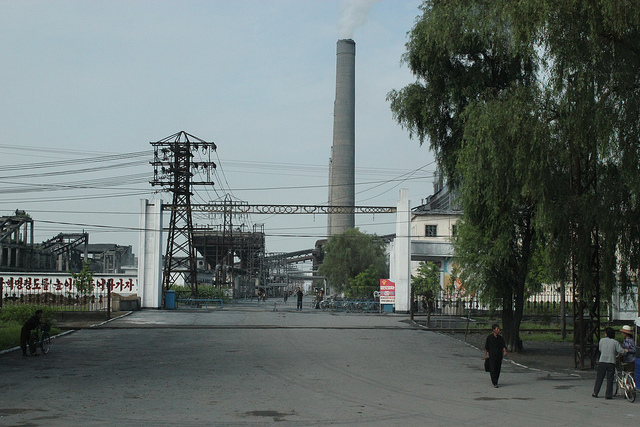Hungnam on:
[Wikipedia]
[Google]
[Amazon]
Hŭngnam is a district of
 The city is home to the Hungnam Fertilizer Complex, which has allegedly also been used to manufacture chemical weapons. Other industrial facilities include the February 8
The city is home to the Hungnam Fertilizer Complex, which has allegedly also been used to manufacture chemical weapons. Other industrial facilities include the February 8
Hamhung
Hamhŭng (''Hamhŭng-si''; ) is North Korea's second-largest city, and the capital of South Hamgyŏng Province. It has an estimated population of 768,551. Located in the southern part of the South Hamgyong province, Hamhung is the main and most p ...
, the second largest city in North Korea
North Korea, officially the Democratic People's Republic of Korea (DPRK), is a country in East Asia. It constitutes the northern half of the Korean Peninsula and shares borders with China and Russia to the north, at the Yalu (Amnok) and T ...
. It is a port city on the eastern coast on the Sea of Japan
The Sea of Japan is the marginal sea between the Japanese archipelago, Sakhalin, the Korean Peninsula, and the mainland of the Russian Far East. The Japanese archipelago separates the sea from the Pacific Ocean. Like the Mediterranean Sea, i ...
. It is only from the slightly inland city of Hamhung. In 2005 it became a ward of Hamhung.
History
The port at Hŭngnam was the site of the Hŭngnam evacuation, a major evacuation of both United Nations military and North Korean civilians during theKorean War
{{Infobox military conflict
, conflict = Korean War
, partof = the Cold War and the Korean conflict
, image = Korean War Montage 2.png
, image_size = 300px
, caption = Clockwise from top:{ ...
in late December 1950. Approximately 100,000 troops and material and 100,000 civilians were loaded onto a variety of merchant ships and military transports totaling 193 shiploads over the weeks leading up to Christmas 1950, and were transported to safety in Pusan and other destinations in South Korea. The evacuation included 14,000 refugees who were transported on one ship, the SS ''Meredith Victory'' - the largest evacuation from land by a single ship. This was made possible by a declaration of national emergency by President Truman issued on 16 December 1950 with Presidential Proclamation No. 2914, 3 C.F.R. 99 (1953). This operation was the culmination of the Battle of Chosin Reservoir
The Battle of Chosin Reservoir, also known as the Chosin Reservoir Campaign or the Battle of Lake Changjin (), was an important battle in the Korean War. The name "Chosin" is derived from the Japanese pronunciation "''Chōshin'', instead of th ...
, in which the embattled UN troops fought their way out of a Chinese trap.
In late 2005, Hŭngnam was demoted from Hŭngnam-si (Hŭngnam City) to Hŭngnam-kuyok (Hŭngnam District) within Hamhung
Hamhŭng (''Hamhŭng-si''; ) is North Korea's second-largest city, and the capital of South Hamgyŏng Province. It has an estimated population of 768,551. Located in the southern part of the South Hamgyong province, Hamhung is the main and most p ...
-si.
Population
The population has been estimated at (variously) 200,000 or 450,000; the official North Korean population figure is 700,000 but this is disputed.Economy
 The city is home to the Hungnam Fertilizer Complex, which has allegedly also been used to manufacture chemical weapons. Other industrial facilities include the February 8
The city is home to the Hungnam Fertilizer Complex, which has allegedly also been used to manufacture chemical weapons. Other industrial facilities include the February 8 Vinylon
Vinylon, also known as Vinalon, is a synthetic fiber produced from polyvinyl alcohol, using anthracite and limestone as raw materials. Vinylon was first developed in Japan in 1939 by Ri Sung-gi, Ichiro Sakurada, and H. Kawakami. Trial production ...
Factory Complex which allegedly is producing UDMH fuel used for liquid fueled rocket and missiles. It is also home to Hungnam Chemical Engineering College.
Transport
Hungnam Station is on thePyongra Line
The P'yŏngra Line is an electrified standard-gauge trunk line of the Korean State Railway in North Korea, running from P'yŏngyang to Rason, where it connects with the Hambuk Line.Kokubu, Hayato, 将軍様の鉄道 (Shōgun-sama no Tetsudō), ...
railway
Rail transport (also known as train transport) is a means of transport that transfers passengers and goods on wheeled vehicles running on rails, which are incorporated in tracks. In contrast to road transport, where the vehicles run on a p ...
.
Administrative divisions
Hŭngnam is divided into 43 ''tong Tong may refer to:
Chinese
* Tang Dynasty, a dynasty in Chinese history when transliterated from Cantonese
* Tong (organization), a type of social organization found in Chinese immigrant communities
*''tong'', pronunciation of several Chinese ch ...
'' (neighbourhoods), 1 '' rodongjagu'' (workers' district) and 5 '' ri'' (villages):
See also
* Hungnam evacuation *List of cities in North Korea
The important cities of North Korea have self-governing status equivalent to that of provinces. Pyongyang, the largest city and capital, is classified as a chikhalsi (capital city), while three cities (see the list below) are classified as t'ŭk ...
*Geography of North Korea
North Korea is located in East Asia in the Northern half of Korea, partially on the Korean Peninsula. It borders three countries: China along the Yalu (Amnok) River, Russia along the Tumen River, and South Korea to the south.
Topography and ...
References
External links
{{DEFAULTSORT:Hungnam Cities in South Hamgyong